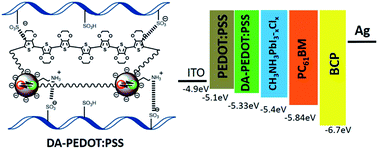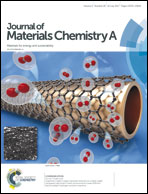Improving the efficiency and stability of inverted perovskite solar cells with dopamine-copolymerized PEDOT:PSS as a hole extraction layer†
Abstract
Despite the superior photovoltaic efficiencies of perovskite solar cells (PSCs), the relatively low long-term stability of the perovskite layer against ambient moisture is a tremendous obstacle for the practical applications of PSCs. Poly(3,4-ethylenedioxythiophene):poly(styrenesulfonate) (PEDOT:PSS) suffers from the limitations of high acidity and low work function. Herein, for the first time, dopamine was doped to modify PEDOT:PSS to develop a new hole extract material (HEM), DA-PEDOT:PSS; moreover, since dopamine is basic in nature, it reduced the acidity of PEDOT:PSS, thereby improving the device stability of planar heterojunction PSCs. The new HEM exhibited extremely low acidity and showed highly enhanced device durability. Moreover, when compared with that of PEDOT:PSS, the work function of DA-PEDOT:PSS was higher and made the DA-PEDOT:PSS-based PSC achieve a higher power conversion efficiency (PCE) of 16.4% due to the obvious enhancement of Voc, and DA-PEDOT:PSS showed significantly enhanced long-term device stability as compared to PEDOT:PSS under unencapsulated condition. Intriguingly, after 28 days of aging, the PCE and Jsc of DA-PEDOT:PSS still remained 85.4% and 89.2%, respectively, as compared to those of PEDOT:PSS (PCE of 60.4% and Jsc of 59.3%). Dopamine-copolymerized PEDOT:PSS showed great advantage over PEDOT:PSS for the enhancement of device durability.



 Please wait while we load your content...
Please wait while we load your content...